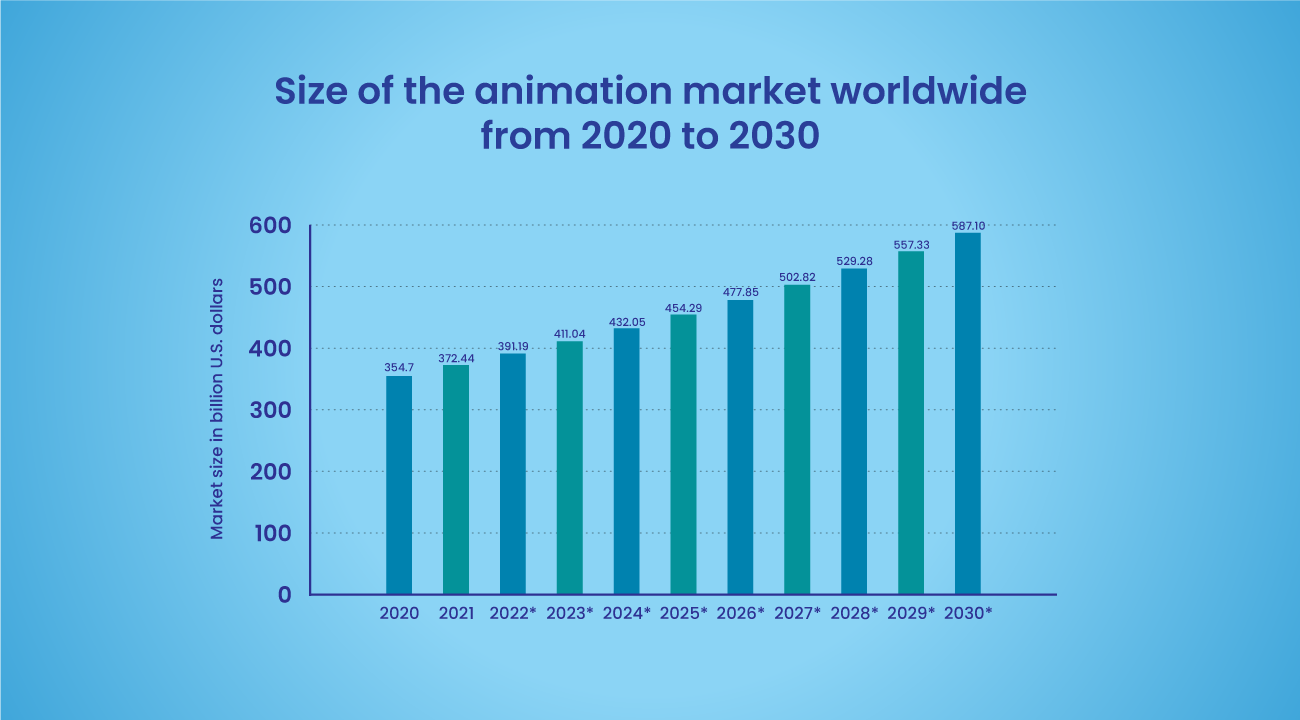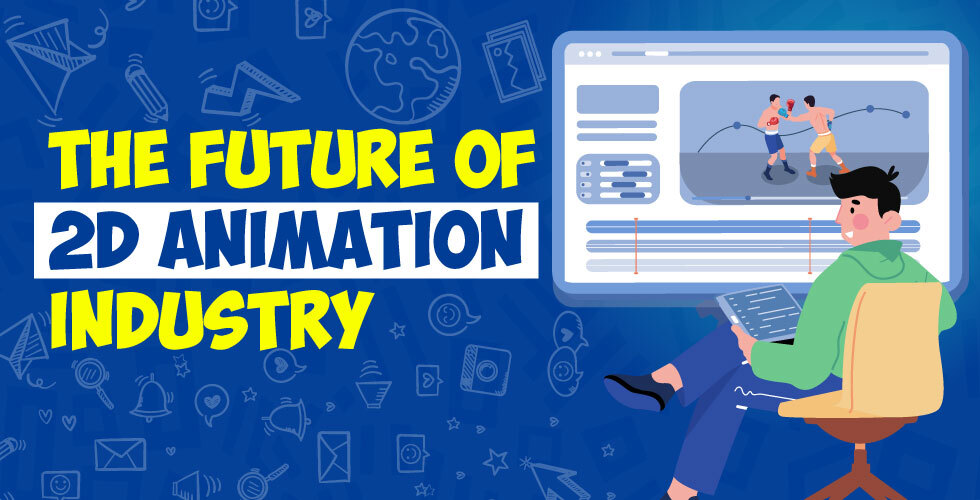The 2D animation industry has a bright future, with opportunities emerging from the advancement of technologies like AR/VR and the growth of digital content creation. While there may be challenges, 2D animation’s popularity and strong following suggest it will remain a vital and innovative medium for years to come.
The majority of the rest of the world has progressed to producing predominantly 3D animation, yet the main market for animation in Japan still favors 2D works. The Japanese animation industry prefers ‘Hand-drawn” animation. Many anime series, including popular titles such as “Sailor Moon,” “Dragon Ball,” and “Naruto,” are primarily 2D animated. The size of the global anime market was estimated at USD 28.61 billion in 2022, and it is anticipated to increase at a CAGR of 9.8% from 2023 to 2030. Throughout the forecast period, market growth is anticipated to be driven by the growing popularity and sales of Japanese anime content internationally. The industry has continued to evolve with new digital tools and techniques, but 2D animation remains a key component of Japanese anime which also goes to show its huge demand in general.
What is 2D Animation?
2D animation refers to a style of animation in which characters, backgrounds, and other elements are created and animated in a two-dimensional space. In other words, everything exists on a flat surface, without the illusion of depth or perspective that is present in 3D animation.
Traditionally, 2D animation involved drawing individual frames by hand on paper and then photographing them in sequence to create the illusion of motion. Nowadays, however, most 2D animation is done digitally using software programs such as Adobe Animate or Toon Boom.
In 2D animation, characters and objects are usually drawn using a series of flat shapes, with outlines and details added to give them form and texture. Animators can then use various techniques, such as tweening and keyframing, to create the illusion of movement and expressiveness in the characters.
2D animation is often used in television shows, movies, commercials, and other forms of visual media. It has a long history and is still a popular and widely used technique today, often praised for its ability to convey emotion and character in a simple, stylized way.
The History of 2D Animation
The history of 2D animation can be traced back to the early days of cinema when animators like Winsor McCay and J. Stuart Blackton began experimenting with hand-drawn animation techniques. In the 1920s, Walt Disney and his team of animators pioneered many of the foundational techniques of 2D animation, including the multiplane camera and the use of synchronized sound.
Throughout the 20th century, 2D animation continued to evolve and become more sophisticated, with the introduction of new technologies like cell animation, which allowed for more efficient and precise animation production. In the 1960s and 1970s, animated television shows like “The Flintstones” and “Scooby-Doo” brought 2D animation to a wider audience, while feature-length animated films like “Snow White and the Seven Dwarfs” and “The Little Mermaid” helped solidify the art form’s place in pop culture.
In the 1980s and 1990s, the rise of computer technology began to change the landscape of animation, with the introduction of digital ink and paint systems and computer-assisted animation techniques. While 3D animation has become increasingly popular in recent years, 2D animation remains a beloved and widely used medium, with artists and studios around the world continuing to push the boundaries of what’s possible in the form.
Recent Statistics on 2D Animation
The 2D animation industry is growing steadily, with increasing demand across a range of different sectors. With the rise in the popularity of online videos and the increasing use of animation in education and marketing, 2D animation is likely to continue to be a popular and lucrative field for years to come.
The global 2D animation market size was valued at USD 25.1 billion in 2020 and is expected to grow at a compound annual growth rate (CAGR) of 4.3% from 2021 to 2028. Moreover, in the United States, the animation industry (including 2D and 3D animation) is expected to grow by 5.5% per year, reaching a total value of USD 270 billion by 2025.
The demand for 2D animation is growing across various industries, including advertising, education, gaming, and entertainment. For example, the gaming industry is expected to be the largest segment for 2D animation, with a market share of over 40%.
The most popular animation software for 2D animation is Adobe Animate, followed by Toon Boom Harmony and Moho.
The global market for online video production, including 2D animation, is expected to reach USD 24.2 billion by 2027, growing at a CAGR of 5.5%.

Why is 2D Animation Important?
2D animation is a powerful tool for storytelling, entertainment, and education. Here are some reasons why it’s important:
- Tradition and nostalgia: It has been around for almost a century, and many people grew up watching classic cartoons like Mickey Mouse or Looney Tunes. It can evoke feelings of nostalgia and comfort, and connect us to our cultural heritage.
- Creative expression: 2D animation allows artists to express their creativity in a variety of ways, from character design and color schemes to backgrounds and visual effects. It’s a medium that offers endless possibilities for experimentation and innovation.
- Accessibility: It can be produced with relatively low costs, which makes it more accessible to independent filmmakers, artists, and educators. This means that the stories and ideas that might not be picked up by big studios can still be shared with the creator’s respective audiences.
- Educational value: It can be used to explain complex concepts in a fun and engaging way. It’s a great tool for teaching children about science, history, and social issues. It can also be used in advertising and marketing to communicate ideas to consumers.
- Versatility: 2D animation can be used in a wide variety of mediums, including feature films, television, video games, and online content. It’s a versatile form of animation that can adapt to different platforms and audiences.
- Timeless appeal: It has a timeless quality that makes it appealing to audiences of all ages. It can tell stories that are both timeless and relevant to contemporary issues.
Overall, 2D animation is important because it’s a powerful storytelling tool that can entertain, educate, and inspire audiences in a variety of ways.
Some Popular 2D Animation Works:
There are several really popular 2D animation films that earned worldwide recognition and have proven that 2D animation has a great future amid the popularity of other types of animation. Here are a few examples of the many popular 2D animation works that have entertained and inspired audiences over the years:
The Lion King
The Little Mermaid
SpongeBob SquarePants
Batman: The Animated Series
Adventure Time
Rick and Morty
The Future of 2D Animation Industry
The future of 2D animation is exciting and full of potential, as the medium continues to evolve and adapt to changing trends and technologies. While 3D animation has certainly become more prominent in recent years, 2D animation remains a vital and important part of the industry, with its own unique strengths and advantages.
One key area where 2D animation is likely to continue to grow is in the realm of digital and interactive media. With the rise of mobile devices, gaming platforms, and virtual reality technology, there are more opportunities than ever for 2D animation to be used in immersive and interactive ways. For example, mobile games like “Angry Birds” and “Candy Crush” have made use of 2D animation to create fun and engaging gameplay experiences, while virtual reality platforms like Oculus have the potential to offer fully immersive 2D animated worlds.
Another area where 2D animation is likely to thrive is in short-form content for social media and streaming platforms. With attention spans getting shorter and shorter, there is a growing demand for bite-sized animated content that can be consumed quickly and easily. Platforms like TikTok, YouTube, and Instagram have already become popular destinations for short-form animated content, and this trend is likely to continue.
At the same time, there is still a strong appetite for traditional 2D animated features and series. As streaming platforms continue on their path to success and global audiences become more diverse, there are opportunities for 2D animation to tell a wide variety of stories that resonate with audiences of all ages and backgrounds. Whether it’s the latest Disney musical or an indie animated feature, 2D animation has the potential to capture the imagination and inspire audiences in new and unexpected ways.
Overall, the future of 2D animation is likely to be shaped by a combination of technological advancements, changing distribution models, and a continued emphasis on creative and storytelling excellence. As long as there is an audience for engaging and visually striking animated content, 2D animation is likely to continue to play an important role in all types of industries.
Misconceptions About 2D Animation
There are also several common misconceptions about 2D animation, which can lead to a misunderstanding of the art form and its potential. Some of the most prevalent misconceptions include:
2D animation is going to become outdated:
While 3D animation has become increasingly popular in recent years, 2D animation still has a vital role in the industry. It offers a distinct aesthetic and can be a cost-effective alternative to 3D animation, particularly for smaller productions or more stylized projects.
2D animation is too simplistic:
While the techniques and tools used in 2D animation may differ from those in 3D animation, the level of complexity and skill required can be just as high. Creating dynamic, believable characters and environments requires a strong understanding of movement, perspective, and storytelling.
2D animation is only for children:
While many classic 2D animated films and shows were aimed at children, the medium is not limited to that demographic only. In fact, some of the most groundbreaking and critically acclaimed animated works of recent years have been in 2D, including films like “The Breadwinner”, “Rick and Morty”, and “Klaus.”
2D animation is a dying art:
Despite the rise of 3D animation, there is still a thriving community of 2D animators and studios creating innovative and engaging content. The continued popularity of anime, for example, demonstrates the ongoing appeal of 2D animation to audiences around the world.
Final Words
The future of 2D animation is bright and full of many possibilities. With new technologies, evolving distribution models, and a continued focus on creativity and storytelling, 2D animation is likely to remain a vital and important part of the entertainment industry for many years to come. Moreover, the adoption of 2D animation in business sectors like marketing has also seen massive growth, for which the industry has been given a new purpose from just being created for entertainment purposes.




